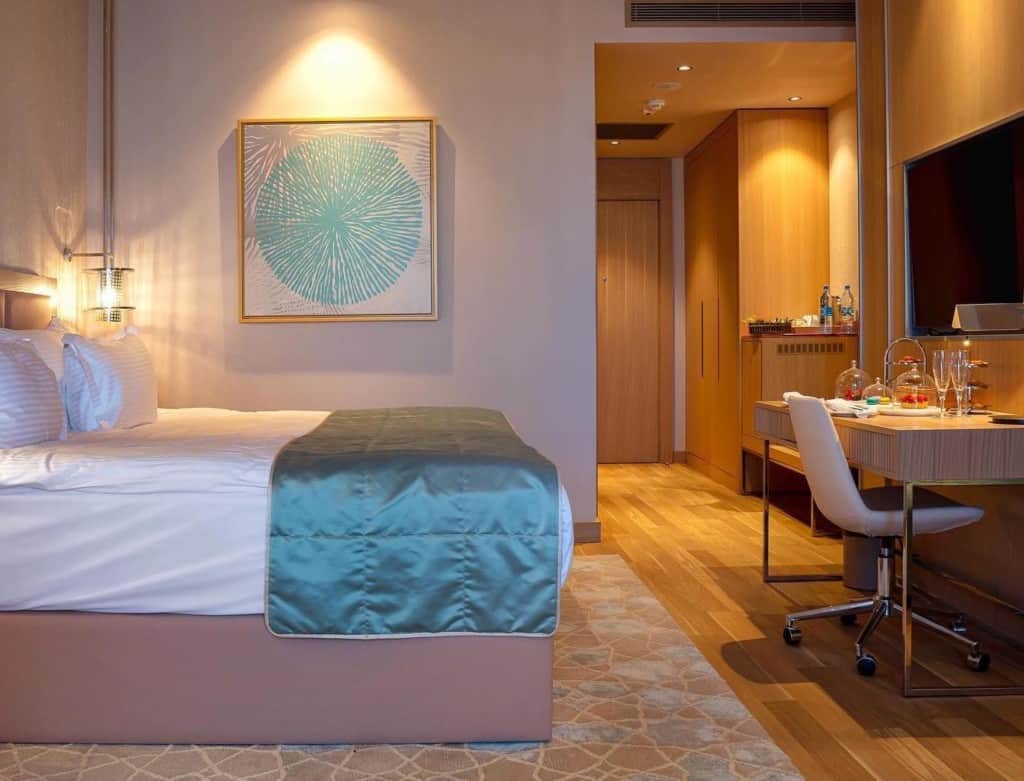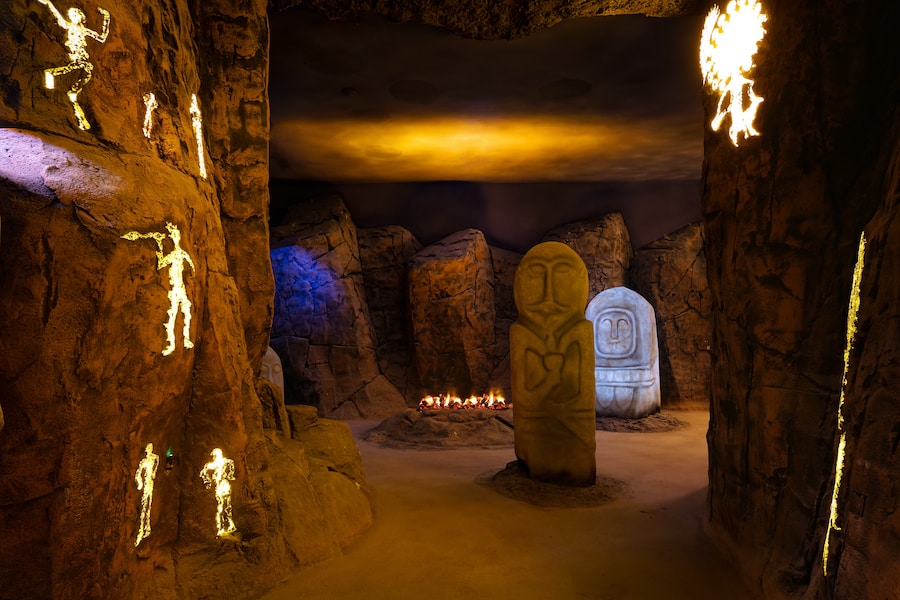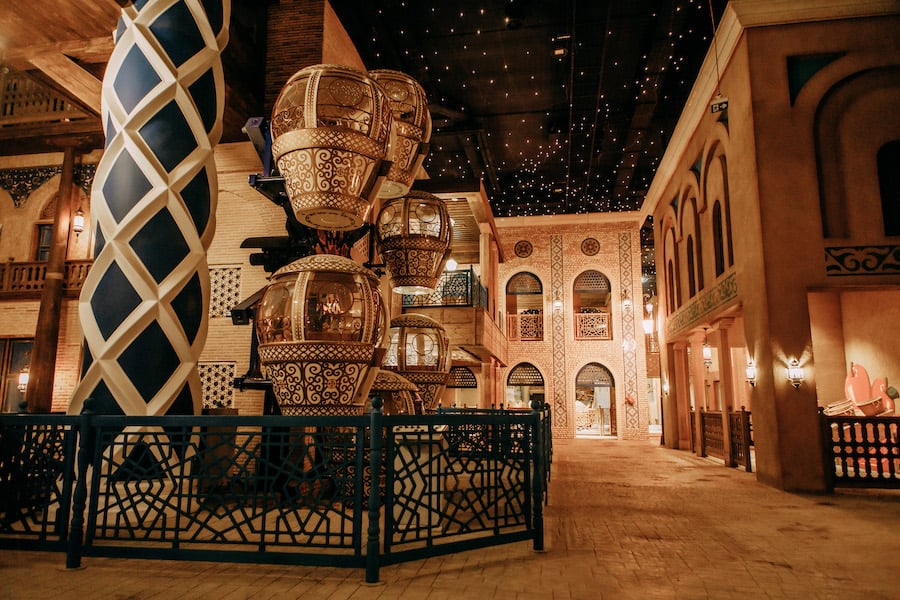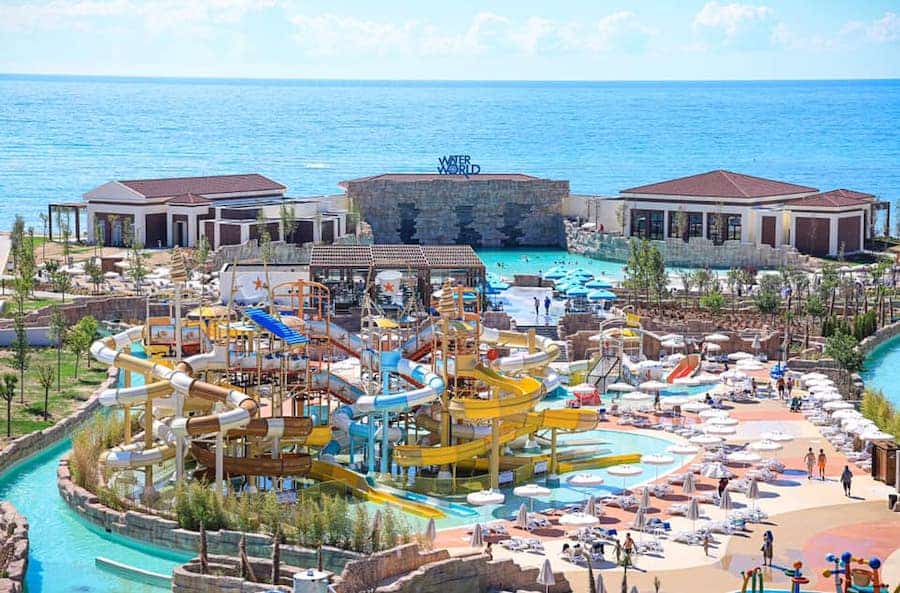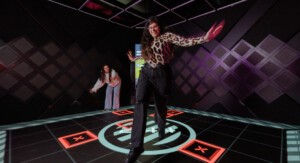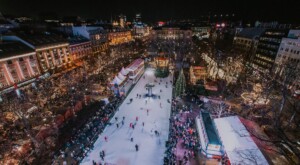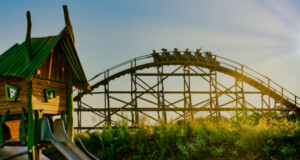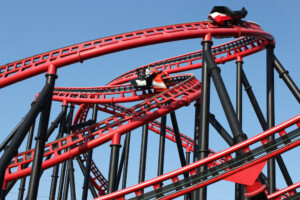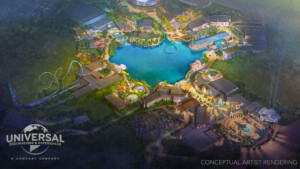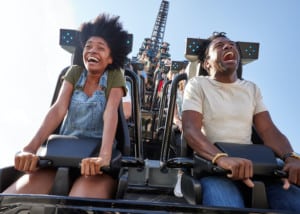After impressing with the Land of Legends theme park in its native Turkey, the Rixos hotel group has launched a new themed entertainment project in Kazakhstan. Karavansaray combines luxury accommodation with a flying theatre, horse show, boat parade, FEC and shopping mall.
Rixos has a strategic partnership with the Accor hotel group. It operates over 30 luxury properties in Turkey, Russia, Kazakhstan, Croatia, Switzerland, Egypt and the United Arab Emirates, and soon Saudi Arabia. The company first dipped its toes into the attractions industry by adding water parks to some of its all-inclusive properties. Yet it was the 2016 launch of The Lands of Legends in Antalya that cemented its status as a park operator.
A joint venture with Emaar Properties and Dragone Productions, the destination in the Belek area of the Turkish tourist province combines both a theme park and water park. Crucially, The Land of Legends operates independently of its neighbouring accommodation.
This too is the case at Karavansaray, which is located in the Kazakh capital of Turkistan (Turkestan), once part of the Persian-Mongolian border region. The project has proved popular with both daytrippers and hotel guests since opening this April:
“During the weekends, you can hardly move,” says Ahmet Çolakoğlu, Chief Officer for New Openings at Rixos. “The privilege hotel guests get is that they are at the centre of everything.”
Celebrating Central Asia’s trading history
Karavansaray’s name (Caravan Palace) is a nod to the ancient ‘caravan’ trading roots of Central Asia. Unlike most of Rixos’ other hotels and resorts, it occupies an inland location. This was chosen for its cultural and religious significance. It stands just 500 metres from the city’s ancient Mausoleum of Khawaja Ahmed Yasawi, a UNESCO World Heritage Site.
Representing Rixos’ fifth hotel project in Kazakhstan, so far 74,000 square metres of an available 20 hectares have been developed, at a cost of between US$400-450 million. Whilst traditional Central Asian architecture inspired the look of its buildings, Kazakh myths and legends run through its shows and attractions.
Construction was handled by Sembol Insaat. This is an associated company of Rixos, which has been doing business in Kazakhstan for the last three decades. During that time it has constructed some of the country’s most noteworthy new buildings.
Responsible for the design of all Karavansaray’s themed entertainment offerings was Chris Lange’s Creative Studio Berlin. This follows an earlier collaboration with Rixos on Masha and the Bear Land of Laughter at The Land of Legends.
Karavansaray’s entertainment offer
The Kyz-Kuu Horse Show was created by Mario Luraschi. The renowned trainer and stunt rider previously directed shows at Disneyland Paris and Europa-Park. He has also worked on many film and television productions, including The Brothers Grimm, Mr Nobody and Versailles.
There’s further live performance after dark in a boat parade and fountain show on the canal that runs alongside the mall’s shops and connects the resort’s two hotels. This can be enjoyed for free by all visitors.
Housed inside a building shaped like a bird’s nest with an ornate golden egg on top, the Flying Theatre features an I-Ride system from Brogent Technologies and a ride film by Mack Animation. Passengers on the media-based attraction soar over spectacular landscapes and witness the growth of Kazakh culture.
Meanwhile, an FEC themed as a magical souk promises an extraordinary journey on the Silk Road with its 13 rides and attractions.
Karavansaray – a development beyond definition
The vision of Rixos founder and chairman Fettah Tamince, Karavansaray’s combination of entertainment is perhaps unique. So much so, it’s difficult to think of an accurate term to define the mixed-use development other than an integrated resort.
“I wouldn’t call it a theme park, I wouldn’t call it a hotel, or a shopping mall,” says Çolakoğlu. “We need to find a word!”
“It’s a lifestyle project,” adds Hande Tezerdi, Rixos’ Business Development Director. “In the beginning, the focus was retail, but entertainment is now the driver.”
In this way, Karavansaray very much chimes with the direction in which Tamince see hotels and resorts heading post-pandemic.
“I think we are going to witness longer stays with a lot of visitors, and we have to be prepared with more options,” he told Entrepreneur magazine earlier this year. “You can have the best room, but people want to see a garden and trees, dine or drink outside, have space to play sports. And definitely have better activities for their kids.”
Rediscovering Kazakh culture
Though privately funded, Karavansaray was developed in close co-operation with the Kazakhstan government.
Çolakoğlu explains the Rixos way of localising its resorts. “Wherever we go, we try to create a destination themed on local legends and culture but adding our own touch on top.”
“It’s a good mixture. The government is happy is to have this kind of project based on their own culture. We are happy because we collect a lot of information and experience. So, next time we go somewhere we know how to do it. And the guests are more than happy to be consuming their own culture seen through the eyes of a foreigner. Because maybe they didn’t realise they had some of these things.”
Hotel guests vs. day trippers
There are a total of 136 rooms (38 in one hotel, 78 in the other) at Karavansaray. This is a reflection of Turkistan’s tourist status compared to some other places Rixos operates. Nevertheless, this part of the city is seen as having potential.
“There are one or two big hotels in Turkistan,” says Çolakoğlu. “But they cannot sell their rooms for even half our price. That’s because we are not selling only the hotels, we are selling the experience.”
Most days, thousands of daytrippers complement the hundreds of hotel guests, who enjoy such perks as complimentary tickets to the horse show.
“There is no local competition,” says Çolakoğlu. “We are busy each and every day. We’re talking 15-20,000 people at weekends. Even on weekdays, there are 5-6,000. Consider that the population of the city is 200,000. That means each weekend 10% of the city comes to spend their day with us. And the next day they come back again!”
Many of the weekend visitors also come from the larger cities of Astana and Almaty. COVID may have prevented tourists from Europe, the Middle East or the Far East. Yet even after the pandemic, as much as 80% of guests are expected to be from Central Asia. That includes other Russian-speaking nations such as Uzbekistan and Turkmenistan. The annual attendance target is 350,000.
Working through the pandemic
After a bad outbreak of the coronavirus last year, Kazakhstan had been experiencing relatively few cases until a spike this summer. “Apparently, people are not very concerned about COVID issues,” says Çolakoğlu. “They are still coming.”
The pandemic caused some inevitable hold-ups to construction. Yet it’s notable how quickly Karavansaray moved from concept design to completion. Just 18 months. Chris Lange and his team had to work within such a short timeframe because architectural planning and construction were already underway.
Karavansaray lies in close proximity to a UNESCO World Heritage Site. Therefore, cultural literacy was also critical in designing the resort and its attractions. That included making revisions to the horse show.
“We were pleased to reach Mario Luraschi, a very nice and gentle person,” says Tezerdi. “But making the show real in the middle of Turkistan was a real challenge under COVID conditions. First, we hired a French crew. Then we did auditions in Almaty and Astana. We also have some actors from the Czech Republic.”
Live horse show
“We tested over 95 horses over three or four months,” says Tezerdi. “Kazakhstan may seem like a country of horses, but the quality of horses was not suitable. We imported the horses from Spain to Mario Luraschi’s place in France, where they had to be quarantined for a month before we could bring them to Kazakhstan. And we had to find a plane that was convenient to carry them.
“In Turkistan, we trained them and did the choreography with Mario and his team. We learned a lot.”
Performed nightly, the Kyz-Kuu Horse Show explores the ancient connection between Kazakh people and the cherished animals. The show uses light effects, stunts, puppets and dancers. Audience members watch a hero fighting for his love in a tulip field and witness a relentless chase over the trees in Lake Kaindy.
Set in the 16th Century, the magical boat parade Kyz-Zhibek & Tolegen brings the canal at the heart of Karavansaray to life with dance, light and music. This is inspired by a similar performance at The Lands of Legends in Turkey. It features a Kazakh folk legend and love story. The show starts from the harbour area and culminates with a fountain finale.
Karavansaray‘s show-stopping flying theatre
It’s difficult to hide the giant building required for a flying theatre. So why not make a feature of it? At Karavansaray, Lange and his team pulled this off with aplomb. The ornate structure takes inspiration from the golden egg of the mythical Samruk bird. This is an eagle-like creature that plays an important role in Turkish culture.
Once inside its shell, an airport-style check-in desk greets guests, before they encounter a series of illuminated petroglyphs (rock carvings). They then come upon a series of ancient yurts. Here, storytellers reveal the ancient, nomadic lifestyle of the local people.
In the circular room that follows, a film projected onto the walls takes the audience through the history of what is now Kazakhstan (it only became a nation in 1991). The Samruk appears on screen between each chapter. Finally, the majestic bird stares at guests then screeches and flies away towards the doors on the other side. The journey had only just begun!
The 40-seat Brogent I-Ride at the heart of the experience is the first media-based attraction of its kind in Central Asia. Passengers are accompanied again by the Samruk as their seats dance in front of a curved screen showing the ‘Flying Over Kazakhstan’ film from Mack Animation.
Since the content was produced during lockdown, the German company was unable to secure any helicopter footage of the 30+ landmarks featured. Therefore the 5.5-minute long production is entirely computer-generated. With no limits on flight, audiences are taken to high speeds, low to the ground, underwater, and even on a rocket launch from Baikonur Cosmodrome (launch complex of the Sputnik 1 satellite).
The souk where the stalls are not what they seem
In the Magical Souk family entertainment centre, amusement rides rub shoulders with intricate ornaments, colourful mosaics and beautifully woven fabrics. Several attractions have even been themed to look like market stalls that magically come to life. Such as a flying carpet draped in carpets or bumper cars designed to look like sacks of spices.
Chris Lange’s concept for the FEC impressed the team at Rixos, says Tezerdi. “We were expecting other ideas as well. But the first time we saw this concept, we were in love, so we didn’t ask for a second version. Chris did a good job.”
In addition to Lange’s work, schematic design was provided by Scruffy Dog. The SBF/Visa Group supplied a large chunk of the FEC’s attractions. This included the Spinning Coaster, Drop ’n’ Twist Tower, Pony Adventure, Crazy Carpet, Twing Rings (Demolition Derby), Tea Cup and bumper cars. Zamperla provided the park’s Happy Swing and mini Ferris wheel.
Also featured are the Riot VR double simulator by DOF Robotics, an Extreme Works ropes course, soft play and trampolines by Efesplay, plus a selection of arcade games.
Rixos’ future plans for Kazakhstan
Çolakoğlu says Rixos has no expansion plans for the new resort in the next five years. “We will see how quickly the city develops. If we are to expand, we will probably add more hotels and extend the retail area. We could also have some other anchor entertainment projects.”
The hotel group has already opened another entertainment project elsewhere in Kazakhstan. As a 5-star all-inclusive beachfront property, Rixos Water World Aktau is more in line with Rixos’ resorts in other countries. It debuted last year with a 40,000 sq m water park, but now also boasts a 150,000 square metre theme park. Suppliers include Zamperla.
“Aktau was once an industrial area. But the Kazakhstan government made a big master plan to turn into the tourist destination of the country,” says Çolakoğlu. “It’s a nice area overlooking the Caspian Sea, which runs between Azerbaijan and Kazakhstan. But the water on the Kazakh side is crystal clear.”
Rixos plans to develop 750,000 sq m of a 200-hectare site at Rixos Water World Aktau. As well as the theme park, there will soon be a Fairmont hotel, complementing the existing 500 room property. Opening by spring 2022 will be a further three hotels, residential accommodation, a golf course and villas.
Turkey might be where it all started for Rixos. However, says Çolakoğlu: “We pay a lot of importance to Kazakhstan.”



